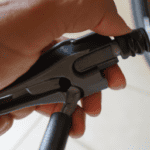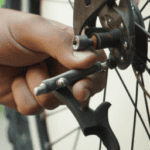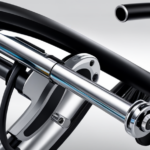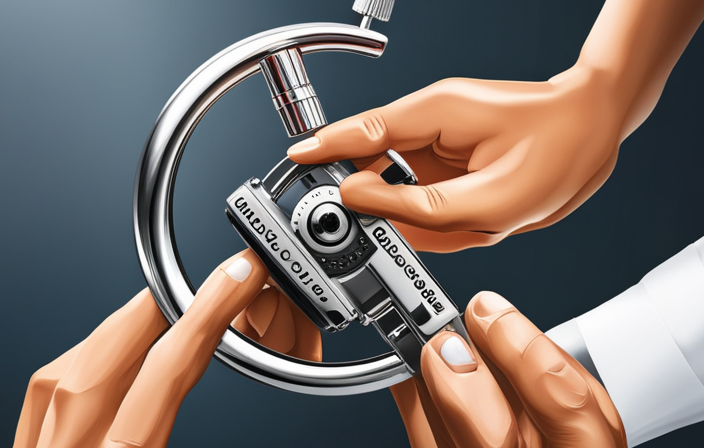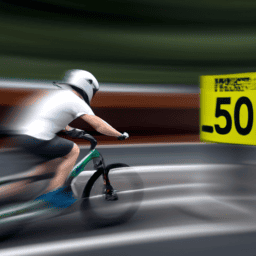Have you ever been in the situation where you’re cycling downhill and suddenly realize your brakes aren’t functioning properly? That immediate sense of alarm can be quite jarring, and it’s certainly not an experience you’d wish to repeat.
As someone who loves cycling, I have encountered this problem more times than I care to remember. Fortunately, I’ve learned how to bleed bicycle brakes, and it’s a skill that every cyclist should have in their arsenal.
Bleeding your bike’s brakes involves removing any air bubbles from the hydraulic system. This is important because air bubbles can cause your brakes to feel spongy and unresponsive, which can be dangerous when you’re cycling on steep terrain or in traffic.
In this article, I will guide you through the steps of bleeding your bike’s brakes, so that you can ride with confidence and peace of mind.
Key Takeaways
- Bleeding bike brakes requires necessary tools such as a bleed kit, brake fluid, and rubber gloves.
- It is important to inspect bike components before bleeding brakes and to consult the manual for compatible brake fluid.
- To successfully bleed brakes, steps include removing brake pads, opening the brake lever and reservoir, attaching a syringe to the bleed nipple, slowly depressing the brake lever, tightening the bleed nipple, and refilling the reservoir.
- Regular maintenance, including checking brake pads for wear and replacing them as needed, is crucial for optimal brake performance.
Gather the Required Tools and Materials
Before you can start bleeding your bike brakes, you’ll need to gather all the necessary tools and materials.
First, you’ll need a bleed kit, which includes a syringe, tubing, and fittings. You’ll also need brake fluid, which comes in different types such as DOT or mineral oil. Make sure to consult your bike’s manual or manufacturer to know which type of brake fluid is compatible with your bike’s brakes.
Aside from the kit and the fluid, it’s also important to wear rubber gloves to avoid getting brake fluid on your skin.
Common brake bleeding mistakes include not using the correct type of brake fluid, not using enough fluid or too much, and not properly tightening the fittings. By gathering all the necessary tools and materials, you’ll be able to avoid these mistakes and ensure a successful brake bleeding process.
With everything in hand, it’s time to prepare your bike for the bleeding process.
Prepare Your Bike
First, you’ll want to take a moment to examine your ride. Imagine yourself crouched down in front of your trusty steed, checking each component with a critical eye.
Here are a few things to look out for:
-
Check the brake pads: Are they worn down or cracked? If so, it’s time for a replacement.
-
Inspect the brake cables: Are they frayed or damaged? If yes, it’s best to replace them.
-
Check the brake fluid level: If it’s low, top it up with the appropriate fluid.
-
Clean the brake system: Use a clean rag to wipe down the calipers and rotor. This will help to remove any dirt or debris that could affect the brake’s performance.
Once you’ve completed your inspection and cleaning, you’re ready to move on to the next step of bleeding your brakes. This process may seem daunting, but with the right tools and techniques, you’ll be back on the road in no time.
Bleed the Brakes
Now that you’ve taken the time to inspect and clean your bike’s brake system, it’s time to ensure optimal performance by properly maintaining its fluid levels. Bleeding your bike’s brakes is a crucial step in this process. This involves removing any air bubbles that may have entered the brake lines, which can cause the brakes to feel spongy or ineffective. Here’s a step by step guide on how to bleed your bicycle brakes:
| Step | Procedure | Tools Required |
|---|---|---|
| 1 | Remove the brake pads | Allen key |
| 2 | Open the brake lever and reservoir | Brake fluid, syringe |
| 3 | Attach the syringe to the bleed nipple | Brake fluid, syringe |
| 4 | Slowly depress the brake lever | Bleed block |
| 5 | Tighten the bleed nipple and refill the reservoir | Brake fluid, syringe |
Common mistakes to avoid during this process include over-tightening the bleed nipple, which can damage the threads, and not using the proper brake fluid for your bike’s system. If you encounter any issues during the bleeding process, troubleshooting tips can include checking for leaks, ensuring the bleed nipple is fully tightened, and double-checking that all air bubbles have been removed. With these steps completed, you can now move on to testing your brakes to ensure they’re working properly.
Test Your Brakes
Before hitting the road, it’s important to test your brakes to make sure they’re functioning properly.
To do this, I start by checking for air bubbles in the brake lines, which can cause weak or inconsistent braking.
Next, I inspect the brake calipers and brake pads for any signs of leaks or damage.
Finally, I take my bike for a test ride, making sure to apply the brakes at various speeds to ensure they’re responsive and strong.
By following these steps, I can feel confident in the safety and reliability of my bike’s braking system.
Checking for Air Bubbles
Make sure you don’t skip this crucial step – check for any sneaky air bubbles lurking in your brake system. It’s a common mistake to assume that your brakes are properly bled just because they feel okay. However, air bubbles can hide in the system and cause serious problems down the line. To avoid any issues, follow these steps:
-
First, fill your brake lever reservoir with fresh brake fluid. Make sure it’s the right type for your brakes.
-
Next, slowly squeeze your brake lever and keep an eye on the reservoir. If you see any air bubbles rising to the top, it means there’s air in the system.
-
To troubleshoot, try tapping the brake lines with a rubber mallet to dislodge any bubbles.
-
If that doesn’t work, you may need to bleed your brakes again.
After ensuring that there are no air bubbles present, you should move on to checking for brake fluid leaks.
Checking for Brake Fluid Leaks
To check for brake fluid leaks, it’s important to keep an eye out for any wet spots or puddles underneath your bike after a ride. Identifying leaks and troubleshooting issues can save you from potential brake failure and ensure your safety on the road. To make the process easier, I’ve created a table below that outlines different areas where leaks may occur and what to look for.
| Area of Leak | Possible Cause | What to Look For |
|---|---|---|
| Caliper | Damaged piston seal | Brake fluid on the caliper body or brake pad |
| Master Cylinder | Damaged piston seal | Brake fluid on the handlebar or brake lever |
| Brake Line | Cracked or damaged line | Wet spots or puddles along the brake line |
| Bleeder Valve | Loose or damaged valve | Brake fluid dripping from the valve |
| Brake Hose | Cracked or damaged hose | Wet spots or puddles along the hose |
By checking these areas and keeping an eye out for any signs of leaks, you can identify and troubleshoot any potential issues before they become a bigger problem. Once you’ve checked for leaks, it’s time to move on to the test ride to ensure that your brakes are functioning properly.
Test Ride
Now it’s time to take your bike for a spin and ensure that everything feels smooth and responsive. During the test ride, pay close attention to the brake performance and how the bike handles.
Start by giving the brakes a series of light taps to see if they engage smoothly and consistently. If the brakes feel spongy or unresponsive, there may still be air in the system that needs to be bled out. If this is the case, repeat the bleeding process until the brakes feel firm and responsive.
Once the brakes feel good, take the bike for a short ride around the block. Test the brakes at different speeds and in different conditions, such as going uphill or downhill. Pay attention to how the bike handles and if it feels balanced.
If everything feels good, then you can move on to regular maintenance to keep your brakes working optimally. One important tip is to regularly check your brake pads and replace them as needed.
Maintenance Tips
During regular maintenance, it’s important to keep an eye on the brake pads as worn pads can lead to decreased stopping power. To ensure the longevity of your brake pads, there are a few tips for preventing brake fluid contamination.
Firstly, always make sure to use a clean container when refilling or bleeding your brakes. Any dirt or debris can easily contaminate the fluid and affect the performance of your brakes.
Secondly, avoid touching the brake rotors or pads with your bare hands as the oils from your skin can also contaminate the brake system.
Lastly, always make sure to tighten the brake bleeder valve before removing the brake reservoir cap to prevent any air or debris from entering the system.
In addition to preventing brake fluid contamination, it’s also important to know when to replace your brake pads. Worn brake pads can lead to decreased stopping power and cause damage to the brake rotors.
As a general rule of thumb, brake pads should be replaced when the pad thickness is less than 3mm. However, it’s important to also visually inspect the pads for any signs of uneven wear or damage.
By regularly inspecting and replacing your brake pads, you can ensure that your brakes are performing at their best and keep yourself safe on the road.
Frequently Asked Questions
What should I do if I accidentally over-bleed my brakes?
If I accidentally over-bleed my brakes, I would immediately remove the brake pads and squeeze the lever to push the pistons back into the caliper. Recovery steps include refilling the brake fluid and re-bleeding the brakes. Prevention measures include being cautious and monitoring the fluid level during the bleeding process.
Can I use any brake fluid for my bike brakes or is there a specific type I need to use?
Choosing the right brake fluid for your bike is crucial for optimal performance. Did you know that using the wrong brake fluid can cause damage to your bike? Proper maintenance involves using the correct fluid and following manufacturer recommendations.
How often should I bleed my bike brakes?
As a general rule, I bleed my bike brakes every six to twelve months. However, the frequency depends on the usage and condition of the brake system. Signs of needing a brake bleed include spongy lever feel, reduced stopping power, or visible air bubbles in the brake line.
Is it necessary to replace brake pads every time I bleed my brakes?
Replacing brake pads is not necessary every time you bleed your brakes. However, it’s important to check their lifespan and condition. Reusing brake fluid may introduce contaminants that can affect brake pad wear and performance.
How can I tell if my brakes need to be bled or if there is another issue with my bike?
If my brakes feel spongy or weak, or if I hear a grinding noise when braking, there may be an issue with my bike brakes. Signs of worn brake pads or common bike brake issues should be addressed promptly to ensure safe and effective braking.
Conclusion
In conclusion, bleeding your bicycle brakes is an important maintenance task that’ll keep your bike running smoothly and safely.
By following the steps outlined in this article, you can ensure that your brakes are working properly and that you’re able to stop quickly when needed.
But don’t just take my word for it. There’s a theory that suggests poorly maintained brakes are a leading cause of bicycle accidents.
While this theory may not be proven, it’s certainly worth investigating.
By taking the time to properly maintain your brakes, you can help prevent accidents and ensure that you’re able to enjoy your rides safely.
So grab your tools and get to work – your brakes (and your safety) will thank you!



